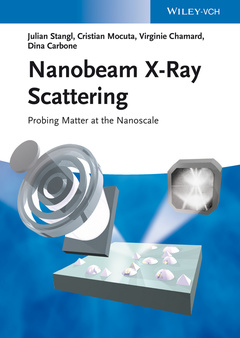Nanobeam X-Ray Scattering Probing Matter at the Nanoscale
Auteurs : Stangl Julian, Mocuta Cristian, Chamard Virginie, Carbone Dina

For scientists using synchrotron radiation or students and scientists with a background in X-ray scattering methods in general.
X-RAY DIFFRACTION PRINCIPLES
-Introduction
-Beam Coherence
-Specific Properties of Different Sources: Laboratory vs
Synchrotron vs FEL
FOCUSING OF X-RAYS
-Beam Propagation and Modeling
-Focusing Principles Available for the Hard X-Ray Regime
-Clasic Microfocusing Devices
-Practical Issues
SCATTERING EXPERIMENTS USING NANOBEAMS
-From the Ensemble Average Approach Towards the Single
Nanostructure Study
-Diffraction from Single Nanostructures
-Scanning X-Ray Diffraction Microscopy
-Other Types of Contrast
-Local X-Ray Probe Experiments from Organic Samples
-Local X-Ray Probe Experiments from Biological Samples
NANOBEAM DIFFRACTION SETUPS
-Beam Positioning on the Nanoscale
-Stability Issues: Maintaining the Spot on the Sample
During Scanning Angles, Vibrations
-Active Systems to Maintain the Beam Position on the
Sample Constant
-Restriction of Different Setups
-Detector Issues: Resolution in Real and Reciprocal
Space, Dynamic Range, Time Resolution
SPECTROSCOPIC TECHNIQUES USING FOCUSED BEAMS
-Micro/Nano-EXAFS, XANES. Fluorescence
-A Side Glance on Soft X-Ray Applications
COHERENT DIFFRACTION
-More on Coherence Properties of Focused X-Ray Beams
-The Use of Phase Retrieval Instead of Modeling
Approaches
-Different Retrieval Algorithms
-Shape Determination of Single Structures (Retrieving
the Modulus of Electron Density)
-Strain Determination (Retrieving the Phase of Electron
Density)
-Fresnel Coherent Diffractive Imaging
-Holographic Approaches (Using a Reference Wave Instead
of Numerical Phase Retrieval)
-Ptychography (For Extended Objects with Nanoscale
Structure)
-Particular Advantages and Problems when Using Coherent
Diffraction Imaging in the Bragg Case
THE POTENTIAL AND THE LIMITS OF THE METHOD
-Limits in Beam Size
-Limits in Intensity/Brilliance
-Resolution Limits in Real and Reciprocal Space
-Combinations with Other Local Probe Techniques
FUTURE DEVELOPMENTS
-Detector Developments
-Beamlines at Third Generation Synchrotron Sources
-The Role of Free Electron Lasers
Cristian Mocuta is presently working at the French Synchrotron Facility, the 'Synchrotron SOLEIL' and is in charge of the microbeam approaches and their development, for diffraction (µXRD) but also complementary analysis by fluorescence and absorption spectrosopies (µ-XRF and/or µ-XAS). His scientific interest resides in the study of the properties of materials at local scale (µm and below) using mostly x-ray diffraction technique. He obtained his academic degrees at the Joseph Fourier University in Grenoble, France, then joined as a scientist the European Synchrotron Radiation Facility (ESRF) where he was involved in the development of a micro- / nano-diffraction setup.
Virginie Chamard is working on methodological developments of lens-less microscopy techniques at the Fresnel Institute in Marseille (France). Her concern is the imaging of nanocrystal structural properties at the local scale based on the inversion of intensity patterns obtained with coherent x-ray beams. After her academic degrees at the Grenoble University, she had some experiences at the European Synchrotron Radiation Facility and in Germany. Her CNRS position allowed her to successively work with different groups in France, in Grenoble and Marseille and to develop collaborations in the field of coherent x-ray scattering.
Dina Carbone is currently working on the investigation of nanostructures using X-ray scattering techniques. After obtaining her degree at the Max-Plank
Date de parution : 12-2013
Ouvrage de 284 p.
17.8x25.3 cm
Disponible chez l'éditeur (délai d'approvisionnement : 12 jours).
Prix indicatif 131,29 €
Ajouter au panierThème de Nanobeam X-Ray Scattering :
Mots-clés :
scattering; nanofocused; comprehensive; matter; overview; xray; beams; probing; nanoscale; experiments; design; nanobeam; sources; monograph; electron lasers; synchrotron; radiation; wellcollimated; area; progress; brilliant; research
